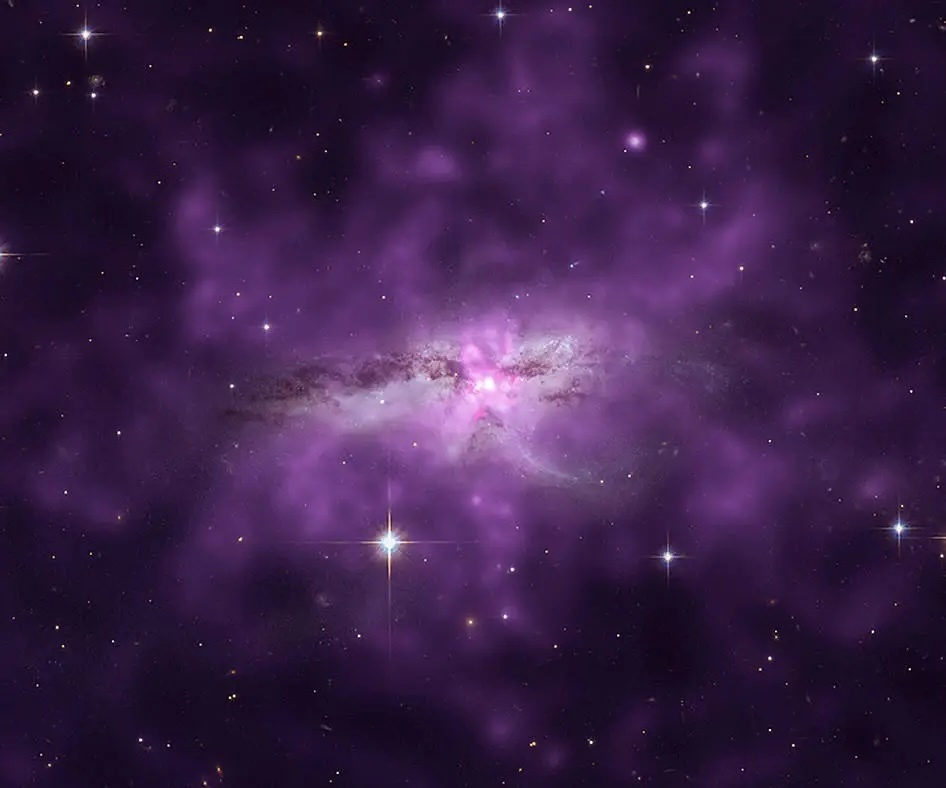10.07.2025
Giant Gas Cloud in System NGC 6240
Scientists have used Chandra to make a detailed study of an enormous cloud of hot gas enveloping two large, colliding galaxies. This unusually large reservoir of gas contains as much mass as 10 billion Suns, spans about 300,000 light years, and radiates at a temperature of more than 7 million degrees.

This giant gas cloud, which scientists call a “halo,” is located in the system called NGC 6240. Astronomers have long known that NGC 6240 is the site of the merger of two large spiral galaxies similar in size to our own Milky Way. Each galaxy contains a supermassive black hole at its center. The black holes are spiraling toward one another, and may eventually merge to form a larger black hole.
Another consequence of the collision between the galaxies is that the gas contained in each individual galaxy has been violently stirred up. This caused a baby boom of new stars that has lasted for at least 200 million years. During this burst of stellar birth, some of the most massive stars raced through their evolution and exploded relatively quickly as supernovas.
The scientists involved with this study argue that this rush of supernova explosions dispersed relatively high amounts of important elements such as oxygen, neon, magnesium, and silicon into the hot gas of the newly combined galaxies. According to the researchers, the data suggest that this enriched gas has slowly expanded into and mixed with cooler gas that was already there.
During the extended baby boom, shorter bursts of star formation have occurred. For example, the most recent burst of star formation lasted for about five million years and occurred about 20 million years ago in Earth’s timeframe. However, the authors do not think that the hot gas was produced just by this shorter burst.
What does the future hold for observations of NGC 6240? Most likely the two spiral galaxies will form one young elliptical galaxy over the course of millions of years. It is unclear, however, how much of the hot gas can be retained by this newly formed galaxy, rather than lost to surrounding space. Regardless, the collision offers the opportunity to witness a relatively nearby version of an event that was common in the early Universe when galaxies were much closer together and merged more often.
In this new composite image of NGC 6240, the X-rays from Chandra that reveal the hot gas cloud are colored purple. These data have been combined with optical data from the Hubble Space Telescope, which shows long tidal tails from the merging galaxies, extending to the right and bottom of the image.
A paper describing these new results on NGC 6240 is available online and appeared in the March 10, 2013 issue of The Astrophysical Journal. The authors in this study were Emanuele Nardini (Harvard-Smithsonian Center for Astrophysics, or CfA, Cambridge, MA and currently at Keele University, UK), Junfeng Wang (CfA and currently at Northwestern University, Evanston, IL), Pepi Fabbiano (CfA), Martin Elvis (CfA), Silvia Pellegrini (University of Bologna, Italy), Guido Risalti (INAF-Osservatorio Astrofisico di Arcetri, Italy and CfA), Margarita Karovska (CfA), and Andreas Zezas (University of Crete, Greece and CfA).
NASA’s Marshall Space Flight Center in Huntsville, Ala., manages the Chandra program for NASA’s Science Mission Directorate in Washington. The Smithsonian Astrophysical Observatory controls Chandra’s science and flight operations from Cambridge, Mass.
Credits: X-ray: NASA/CXC/SAO/E. Nardini et al; Optical: NASA/STScI
Quelle: NASA
+++
Astronomers have just spotted for the first time a huge cloud of cold hydrogen gas just 300 light-years from Earth.
Did you notice something peculiar the last time you gazed at the constellation Corona Borealis, the Northern Crown? Probably not. Yet this part of the sky is home to a cloud of hydrogen molecules that stretches across some 40 times the apparent diameter of the Full Moon. No one knew it was there until now.
The Eos cloud, as the newly discovered structure has been called (after the Greek goddess of dawn), is approximately 100 light-years wide and contains some 5,500 solar masses of cold gas, mostly molecular hydrogen (H2). The densest of such molecular clouds are the birthplaces of stars and planets. With its near side located at just 300 light-years from the Sun, Eos is the molecular cloud closest to us.
“Our discovery of Eos is exciting because we can now directly measure how molecular clouds are forming and dissociating, and how a galaxy begins to transform interstellar gas and dust into stars and planets,” says Blakesley Burkhart (Rutgers University) in a press statement.
Burkhart and her colleagues published their discovery earlier this year in Nature Astronomy. On June 27th, coauthor Thomas Haworth (Queen Mary University London) discussed the result at the 2025 meeting of the European Astronomical Society in Cork, Ireland.
The hydrogen gas in molecular clouds is notoriously difficult to detect, because the molecules are so simple they emit hardly any radiation. That’s why astronomers use the second most abundant molecule, carbon monoxide (CO), as a “tracer”; these molecules emit radiation at a a wavelength of 2.6 millimeters, which radio telescope can detect. However, the Eos cloud contains hardly any CO, which is why it has always escaped detection.
Fortunately, hydrogen does emit some radiation at more energetic wavelengths. The team discovered the cloud in data from the Korean Science and Technology Satellite 1 (STSAT-1). Between 2003 and 2005, the mission’s Far-ultraviolet Imaging Spectrograph (FIMS) mapped large areas of the sky at far-ultraviolet wavelengths. The data became publicly available in 2023.
As Haworth explains, in excited hydrogen molecules, an electron has been boosted to a higher energy state. When that electron comes back down closer to the nucleus, it emits far-ultraviolet radiation in a process called fluorescence. “We don’t know yet what does the exciting,” he says. “It could be cosmic rays or energetic radiation.”
While looking at the FIMS data, Burkhart discovered a weird, crescent-shaped structure that the team later named Eos. Subsequent studies of dust extinction (among other techniques) revealed the cloud’s distance and mass.
“It was rather unexpected that a molecular cloud so close to the Sun could have been completely missed,” says Haworth.
Many molecular clouds (like the one in Orion, for instance) spawn new stars, as bits of the clouds’ gas and dust collapse under their own gravity. However, the Eos cloud appears to be too warm to allow such gravitational collapse.
Indeed, at the Cork meeting, Haworth presented a new analysis of data from the Gaia spacecraft, which is mapping out more than 1 billion Milky Way stars. The analysis, to be published in Monthly Notices of the Royal Astronomical Society, suggests no new stars have formed in this part of the sky over the past tens of millions of years.
Neither will the cloud experience substantial star formation in the future. Eos’s crescent shape appears to be the result of interaction with a plume of hot gas known as the North Polar Spur, which extends upward from the central plane of the Milky Way. Within 6 million years or so, soft X-rays from the North Polar Spur will likely break Eos’s hydrogen molecules apart, dispersing the cloud.
This summer, Haworth and his colleagues will submit a proposal to NASA for a small ultraviolet spectroscopy mission — also called Eos — that would shed more light on the formation and dissociation of molecular clouds. “There are likely other CO-dark clouds out there to discover,” he says.
Quelle: Sky&Telescope
